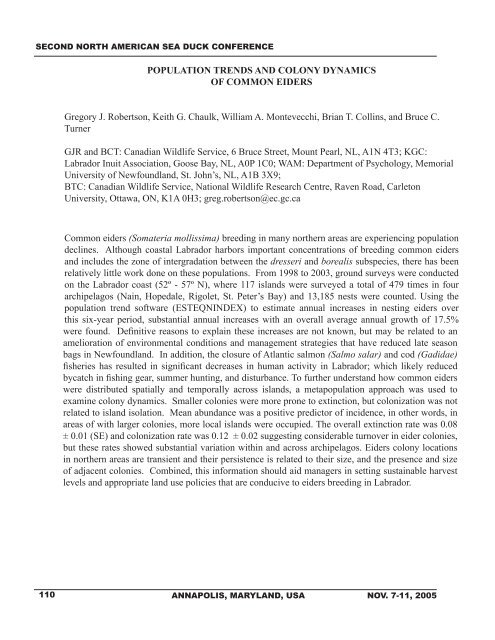Second North American Sea Duck Conference - Patuxent Wildlife ...
Second North American Sea Duck Conference - Patuxent Wildlife ...
Second North American Sea Duck Conference - Patuxent Wildlife ...
Create successful ePaper yourself
Turn your PDF publications into a flip-book with our unique Google optimized e-Paper software.
SECOND NORTH AMERICAN SEA DUCK CONFERENCE<br />
POPULATION TRENDS AND COLONY DYNAMICS<br />
OF COMMON EIDERS<br />
Gregory J. Robertson, Keith G. Chaulk, William A. Montevecchi, Brian T. Collins, and Bruce C.<br />
Turner<br />
GJR and BCT: Canadian <strong>Wildlife</strong> Service, 6 Bruce Street, Mount Pearl, NL, A1N 4T3; KGC:<br />
Labrador Inuit Association, Goose Bay, NL, A0P 1C0; WAM: Department of Psychology, Memorial<br />
University of Newfoundland, St. John’s, NL, A1B 3X9;<br />
BTC: Canadian <strong>Wildlife</strong> Service, National <strong>Wildlife</strong> Research Centre, Raven Road, Carleton<br />
University, Ottawa, ON, K1A 0H3; greg.robertson@ec.gc.ca<br />
Common eiders (Somateria mollissima) breeding in many northern areas are experiencing population<br />
declines. Although coastal Labrador harbors important concentrations of breeding common eiders<br />
and includes the zone of intergradation between the dresseri and borealis subspecies, there has been<br />
relatively little work done on these populations. From 1998 to 2003, ground surveys were conducted<br />
on the Labrador coast (52º - 57º N), where 117 islands were surveyed a total of 479 times in four<br />
archipelagos (Nain, Hopedale, Rigolet, St. Peter’s Bay) and 13,185 nests were counted. Using the<br />
population trend software (ESTEQNINDEX) to estimate annual increases in nesting eiders over<br />
this six-year period, substantial annual increases with an overall average annual growth of 17.5%<br />
were found. Definitive reasons to explain these increases are not known, but may be related to an<br />
amelioration of environmental conditions and management strategies that have reduced late season<br />
bags in Newfoundland. In addition, the closure of Atlantic salmon (Salmo salar) and cod (Gadidae)<br />
fisheries has resulted in significant decreases in human activity in Labrador; which likely reduced<br />
bycatch in fishing gear, summer hunting, and disturbance. To further understand how common eiders<br />
were distributed spatially and temporally across islands, a metapopulation approach was used to<br />
examine colony dynamics. Smaller colonies were more prone to extinction, but colonization was not<br />
related to island isolation. Mean abundance was a positive predictor of incidence, in other words, in<br />
areas of with larger colonies, more local islands were occupied. The overall extinction rate was 0.08<br />
± 0.01 (SE) and colonization rate was 0.12 ± 0.02 suggesting considerable turnover in eider colonies,<br />
but these rates showed substantial variation within and across archipelagos. Eiders colony locations<br />
in northern areas are transient and their persistence is related to their size, and the presence and size<br />
of adjacent colonies. Combined, this information should aid managers in setting sustainable harvest<br />
levels and appropriate land use policies that are conducive to eiders breeding in Labrador.<br />
110 ANNAPOLIS, MARYLAND, USA NOV. 7-11, 2005












